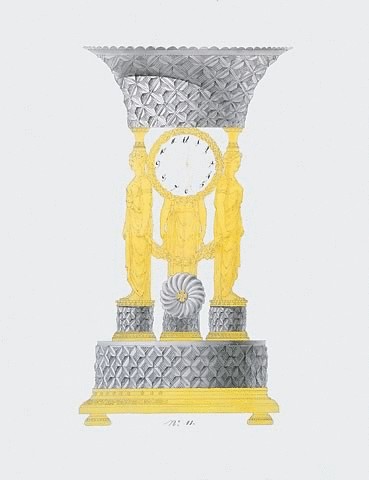Description
Surmounted by a crystal vase of basket form cut with hobnails in a trellis pattern, supported by three female caryatids holding floral swags standing on individual crystal socles decorated en suite, the clock dial within bound oakleaf bezel resting on two of their shoulders, the whorled pendulum bob also of crystal; on similarly cut crystal cylindrical plinth, on beaded feet 17in. high
The Three Graces were the personification of grace and beauty, often represented as the handmaidens of Venus, sharing several of her attributes, including the rose, which could be arranged here in the glass bowl. According to Hesiod, their names were Aglaia, Euphrosyne and Thalia. Seneca described them as standing for the threefold aspect of generosity: giving, receiving and reciprocating; the Renaissance saw them as the three phases of love: beauty, arousing desire, leading to fulfilment, or as personification of Chastity, Beauty and Love. Here, such evocations of Love may be taken to symbolise the bond between king and people, the caryatid figures supporting the "cup" of the nation overflowing with the flowers with which it is meant to be filled.
This design may be a development of the Three Graces centerpiece forming part of a sourtout de table exhibited by Gerard-Jean Galle at the 1819 Paris exhibition (see Ottomeyer & Preschel, II, 711, 30). Ottomeyer & Preschel, I, 389, 5.16.17, also illustrate a pen and ink drawing of circa 1820 (Musee des Arts Decoratifs, Paris) for a surtout de table carrying an elaborate centerpiece related to the present design (but all in gilt bronze and not a clock), the basket filled with real flowers. It is noteworthy that the gallery of that surtout carries circular shields with the French Bourbon coat-of-arms of three fleurs-de-lys, again confirming the French national, political and dynastic symbolism contained within much decoration in the applied art in the Restauration period, as also shown in Galle's comment about a "royal" clock quoted in the Introduction, above, p. XXX.
A differing, centerpiece clock with caryatid figures supporting a basket of flowers, shown at the Paris 1823 Exposition des Produits de l'Industrie, was acquired by the Garde-Meuble of France in 1827. By Lepine et neveu, it was more recently exhibited at Un age d'or des arts decoratifs (#47), and comprised four caryatid Victory figures similarly linked by garlands of flowers, supporting a basket filled to bursting with a towering arrangement of flowers modelled in gilt and patinated bronze, typifying the Restauration taste for flowers as decorative motifs (see Ledoux-Lebard, 1975, 73).
Medium
Watercolour, gouache and pen and ink, on laid paper
Dimensions:
50.80cm wide 92.80cm high (20.00 inches wide 36.54 inches high)
Status
FOR SALE





